Related Research Articles

Looney Tunes is an American animated cartoon franchise produced and distributed by Warner Bros. It began as a series of short films that originally ran from 1930 to 1969, concurrently with its partner series Merrie Melodies, during the golden age of American animation. Following a revival in the late 1970s, new shorts were released as recently as 2014. The two series introduced a large cast of characters, including Bugs Bunny, Daffy Duck, and Porky Pig. The term Looney Tunes has since been expanded to also refer to the characters themselves.
The golden age of American animation was a period in the history of U.S. animation that began with the popularization of sound cartoons in 1928 and gradually ended from 1957 to 1969, where theatrical animated shorts began losing popularity to the newer medium of television animation since in 1957, produced on cheaper budgets and in a more limited animation style by companies such as Terrytoons, UPA, Paramount Cartoon Studio, Jay Ward Productions, Hanna-Barbera, DePatie-Freleng and Filmation, in artefact, The History of Animation became very important in the United States of America.

Leon Schlesinger was an American film producer who founded Leon Schlesinger Productions, which later became the Warner Bros. Cartoons studio, during the Golden Age of American animation. He was a distant relative of the Warner Brothers. As head of his own studio, Schlesinger served as the producer of Warner's Looney Tunes and Merrie Melodies cartoons from 1930, when Schlesinger assumed production from his subcontractors, Harman and Ising, to 1944, when Warner acquired the studio.

Bosko is an animated cartoon character created by animators Hugh Harman and Rudolf Ising. Bosko was the first recurring character in Leon Schlesinger's cartoon series and was the star of thirty-nine Looney Tunes shorts released by Warner Bros. He was voiced by Carman Maxwell, Johnny Murray, and Billie "Buckwheat" Thomas during the 1920s and 1930s and once by Don Messick during the 1990s.

Isadore "Friz" Freleng, credited as I. Freleng early in his career, was an American animator, cartoonist, director, producer, and composer known for his work at Warner Bros. Cartoons on the Looney Tunes and Merrie Melodies series of cartoons. In total he created more than 300 cartoons.

Hugh Harman was an American animator. He was known for creating the Warner Bros. Cartoons and MGM Cartoons studios and his collaboration with Rudolf Ising during the Golden Age of American animation.

Buddy is an animated cartoon character in the Looney Tunes series by Leon Schlesinger Productions. He was the second star of the series, after Bosko.
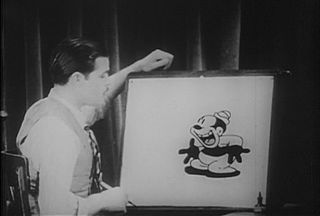
Rudolf Carl Ising, Sr. was an American animator best known for collaborating with Hugh Harman to establish the Warner Bros. and MGM Cartoon studios during the early years of the golden age of American animation. In 1940, Ising produced William Hanna and Joseph Barbera's first cartoon, Puss Gets the Boot, a cartoon featuring characters later known as Tom and Jerry.

Foxy is an animated cartoon character featured in the first three animated shorts in the Merrie Melodies series, all distributed by Warner Bros. in 1931. He was the creation of animator Rudolf Ising, who had worked for Walt Disney in the 1920s.
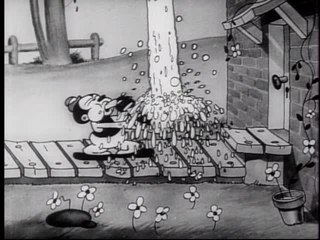
Sinkin' in the Bathtub is the first Warner Bros. theatrical cartoon short as well as the first of the Looney Tunes series. The short debuted in April 1930, at the Warner Bros. Theater in Hollywood. The cartoon features Bosko, and the title is a pun on the 1929 song Singin' in the Bathtub. The film was erroneously copyrighted under the same title as the 1929 song.
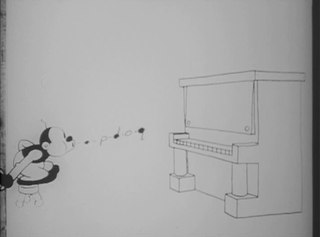
Bosko, the Talk-Ink Kid is a 1929 live-action/animated short film produced to sell a series of Bosko cartoons. The film was never released to theaters, and therefore not seen by a wide audience until 2000 on Cartoon Network's television special Toonheads: The Lost Cartoons. The film was produced on May 29, 1929 and directed by Hugh Harman and Rudolf Ising.
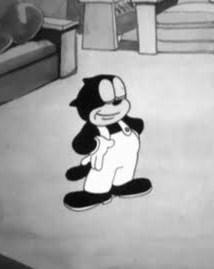
Beans the Cat is an animated cartoon character in the Warner Bros. Cartoons series of cartoons from 1935–1936. Beans was the third Warner Bros cartoon character star after Bosko and Buddy. He is voiced by Billy Bletcher and occasionally by Tommy Bond. He was created by director Friz Freleng. The character was featured in nine cartoons made in 1935 and 1936.
Warner Bros. Cartoons, Inc. was an American animation studio, serving as the in-house animation division of Warner Bros. during the Golden Age of American animation. One of the most successful animation studios in American media history, it was primarily responsible for the Looney Tunes and Merrie Melodies series of animated short films. The characters featured in these cartoons, including Bugs Bunny, Daffy Duck, and Porky Pig, are among the most famous and recognizable characters in the world. Many of the creative staff members at the studio, including directors and animators such as Chuck Jones, Friz Freleng, Robert McKimson, Tex Avery, Robert Clampett, Arthur Davis, and Frank Tashlin, are considered major figures in the art and history of traditional animation.
Carman Griffin Maxwell was an American animator and voice actor.
Happy Harmonies is a series of thirty-seven animated cartoons distributed by Metro-Goldwyn-Mayer and produced by Hugh Harman and Rudolf Ising between 1934 and 1938.

The Metro-Goldwyn-Mayer cartoon studio was an American animation studio operated by Metro-Goldwyn-Mayer (MGM) during the Golden Age of American animation. Active from 1937 until 1957, the studio was responsible for producing animated shorts to accompany MGM feature films in Loew's Theaters, which included popular cartoon characters Tom, Jerry, Droopy, Butch, Spike, Tyke, and Barney Bear.

Hold Anything is the third short in the Looney Tunes series from Warner Bros., released to theaters in October 1930. Featuring Bosko, it is loosely based on the lost film Hold Everything, one of whose songs, "Don't Hold Everything," features prominently in the cartoon. It was directed by Hugh Harman and Rudolf Ising, and animated by Isadore "Friz" Freleng and Norman Blackburn.
This is a listing of all the animated shorts released by Warner Bros. under the Looney Tunes and Merrie Melodies banners between 1930 and 1939, plus the pilot film from 1929 which was used to sell the Looney Tunes series to Leon Schlesinger and Warner Bros. A total of 270 shorts were released during the 1930s.
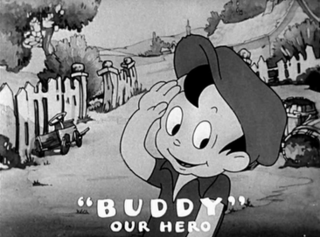
Buddy's Day Out is a 1933 Warner Bros. Looney Tunes cartoon, directed by Tom Palmer. The short was released in theaters on September 9, 1933, premiering with Goodbye Again, and was the first cartoon to feature Buddy, the second star of the series who was created by Earl Duvall.
Rollin "Ham" Clare Hamilton was an early motion picture animator. He was Walt Disney's first hire, and from 1924 to 1928, he worked as an animator for the Alice Comedies and Oswald the Lucky Rabbit shorts. In 1928, Hamilton and several other animators left the Walt Disney Studio to work at Winkler Pictures' new animation studio with the help of Charles Mintz. A year later, Hamilton briefly transferred to Walter Lantz’s new studio before he helped fellow animators Hugh Harman and Rudolf Ising establish their own animation studio. He was one of the primary animators for the Looney Tunes and Merrie Melodies cartoons. From 1929 to 1934, he animated the Bosko character in the Harman and Ising studio.
References
- ↑ Lenburg, Jeff (1991). The encyclopedia of animated cartoons. Facts On File Inc. pp. 52–53. ISBN 0-8160-2775-7.
- ↑ Lenburg, Jeff (1991). The encyclopedia of animated cartoons. Facts On File Inc. p. 80. ISBN 0-8160-2775-7.
- ↑ Dobson, Nichola (2010). The A to Z of Animation and Cartoons. Scarecrow Press. p. 58. ISBN 9781461664024.
- ↑ Barrier, Michael (2007). The Animated Man: A Life of Walt Disney. University of California Press. pp. 46–51. ISBN 978-0520256194.
- ↑ Putterman, Barry, "Le origini: il periodo Harman-Ising (1930-1935)" Griffithiana Vol VII nr 16-17 (June 1984); p 10.
- ↑ Putterman, Barry, "Le origini: il periodo Harman-Ising (1930-1935)" Griffithiana Vol VII nr 16-17 (June 1984); p 11.
- ↑ "Rudolf Ising; Founded Cartoon Studios". Los Angeles Times . 22 July 1992.
- ↑ Putterman, Barry, "Le origini: il periodo Harman-Ising (1930-1935)" Griffithiana Vol VII nr 16-17 (June 1984); p 13.
- ↑ Putterman, Barry, "Le origini: il periodo Harman-Ising (1930-1935)" Griffithiana Vol VII nr 16-17 (June 1984); p 14.
- ↑ Joseph Barbera on Fred Quimby being nominated for the Academy Award for "Tom and Jerry"
- ↑ Rudolf Ising’s “The Prospecting Bear” (1941)
- ↑ MGM’s “The Bear and The Beavers (1942)
- ↑ Harman-Ising’s “Good Wrinkles” (1951)
- ↑ Webb, Graham (2011). The animated film encyclopedia : a complete guide to American shorts, features and sequences, 1900-1999 (2nd ed.). McFarland & Company. p. 79. ISBN 978-0-7864-4985-9.
- ↑ "The Adventures of Sir Gee Whiz on the Other Side of the Moon (1960)". IMDb.com. Retrieved 2015-05-30.
- ↑ "Cartoonbrewfilms.com". Cartoonbrewfilms.com. 21 October 2007. Retrieved 2015-05-30.
- ↑ "Interviews: Hugh Harman". MichaelBarrier.com. Retrieved 2015-05-30.